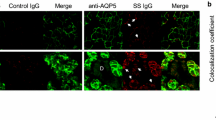Summary
Cytochemical detection of surface polysaccharides on mouse parotid acinar cells was carried out by sequential incubation of fixed slices in periodic acid, thiosemicarbazide and osmium tetroxide. Mice were previously treated with isoproterenol (0.67 μmoles or 1.5 nmoles per g bd wt), pilocarpine (0.27 μmoles per g bd wt) or saline.
Parotid glands from control mice showed acinar cells with a strong positive reaction at the apical, lateral and basal surfaces. The osmium deposits on the cell surface formed parallel rows of dense granules large enough to permit an easy identification of the polysaccharides.
A low dose of isoproterenol and pilocarpine that induced only secretion, produce a slight reduction of the reactivity at the apical cell surface 30 min and 2 h after injection. No other change in the reactivity of the cell surface polysaccharides was found in the times observed.
The high dose of isoproterenol that induces secretion and cell proliferation, provoked at 30 min the same lower reactivity at the apical surface as described above. However, at 12 and 20 h after the high dose of isoproternol there is a marked decrease or no reactivity at the apical and lateral cell surfaces. At 36 h, no reactivity was observed at the apical, lateral nor basal surface.
The results presented here strongly suggest that polysaccharides are removed from the surface of acinar parotid cells, or that the cell surface is exchanged with inmature secretory vesicles, upon stimulation to secretion and cell proliferation. These polysaccharides are not affected or lost, with stimuli that induce only secretion.
Similar content being viewed by others
References
Amsterdam, A., Ohad, I., Schramm, N.: Dynamic changes in the ultrastructure of the acinar cell of the rat parotid gland during the secretory cycle. J. Cell Biol. 41, 753–773 (1969)
Barka, T.: Stimulation of DNA synthesis by isoproterenol in the salivary gland. Exp. Cell Res. 39, 355–364 (1965)
Baserga, R.: Inhibition of stimulation of DNA synthesis by isoproterenol in submandibular glands of mice. Life Sci. 5, 2033–2039 (1966)
Bernhard, W., Avrameas, S.: Ultrastructural visualization of cellular carbohydrate components by means of concanavalin. Exp. Cell Res. 64, 232–236 (1971)
Bernhard, W.: The use of phytoagglutinins coupled with peroxidase for the localization of specific surface receptors. In: Electron microscopy and cytochemistry (Wisse, E., Daems, W.Th., Molenaar, I., van Duijn, P., eds.), p. 283–294. Amsterdam: North-Holland Publ. Comp. 1973
Durham, J., Baserga, R., Butcher, F.: The effect of isoproterenol and its analogs upon adenosine 3′,5′-monophosphate and guanosine 3′, 5′-monophosphate levels in mouse parotid gland in vivo. Biochim. Biophys. Acta 372, 197–217 (1974)
Gasic, G., Berwick, L.: Hale stain for sialic acid containing mucins. Adaptation to electron Microscopy. J. Cell Biol. 19, 223–228 (1963)
Leiva, S., Gonzalez, J.: Fine cytochemical detection of acid mucopolysaccharides in growing hyphae of Neurospora crassa. Histochemistry 48, 121–127 (1976)
López, R., Galanti, N.: The effect of isoproterenol upon the chemical composition of plasma membranes in the mouse parotid gland. Differentiation 5, 155–160 (1976)
Nicolson, G.L., Singer, S.J.: Ferritin-conjugated plant agglutinins as specific saccharide stains for electron microscopy. Application to saccharides bound to cell membranes. Proc. Natl. Acad. Sci. 68, 942–945 (1971)
Nicolson, G.L.: Transmembrane control of the receptors on normal and tumor cells. I. Cytoplasmic influence over cell surface components. Biochim. Biophys. Acta 457, 57–108 (1976a)
Nicolson, G.L.: Transmembrane control of the receptors on normal and tumor cells. II. Surface changes associated with transformation and malignancy. Biochim. Biophys. Acta 458, 1–72 (1976b)
Przelecka, A., Wyroba, E.: Cytochemical studies on the surface coat of Paramecium aurelia. In: Electron microscopy and cytochemistry (Wisse, E., Daems, W.Th., Molenaar, I., van Duijn, P., eds.), p. 309–312. Amsterdam: North-Holland Publ. Comp. 1973
Rambourg, A., Leblond, C.P.: Electron microscope observations on the carbohydrate rich cell coat present at the surface of cells in the rat. J. Cell Biol. 32, 27–53 (1967)
Rambourg, A.: Localisation ultrastructurale et nature du material coloré au niveau de la surface cellulaire par le mélange chromique-phosphotungstique. J. Microscopie 8, 325–342 (1969)
Rambourg, A.: Morphological and histochemical aspects of glycoproteins at the surface of animal cells. Int. Rev. Cytol. 31, 57–114 (1971)
Roth, J.: Ultrastructural detection of lectin receptors by cytochemical affinity reaction using mannan Iron complex. Histochemistry 41, 365–368 (1975)
Sans, J., Galanti, N., López, R.: Secretion, DNA synthesis and mitosis in mouse parotid gland. Effect of different stimuli. Actas Reunión Anual Soc. Biol. de Chile, 55–56 (1976)
Seligman, A.M., Hanker, J.S., Wassekrug, H., Dmochowski, H., Katzoff, L.: Histochemical demonstration of some oxidized macromolecules with thiocarbohydrazide (TCH) or thiosemicarbazide (TSC) and osmium tetraoxide. J. Histochem. Cytochem. 13, 629–639 (1965)
Simson, J.A.V.: Discharge and restitution of secretory material in the rat parotid gland in response to IPR. Z. Zellforsch. 101, 175–191 (1969)
Simson, J.A.V., Spicer, S.S., Hall, B.J.: Morphology and cytochemistry of rat salivary gland acinar secretory granules and their alteration by isoproterenol. J. Ultrastruct. Res. 48, 465–482 (1974a)
Simson, J.A.V., Spicer, S.S.: Cytochemical evidence for cation fluxes in parotid acinar cells following stimulation by isoproterenol. Anat. Rec. 178, 145–155 (1974b)
Thiéry, J.P.: Mise en évidence des polysaccharides sur coupes fines en microscopie électronique. J. Microscopie 6, 987–1018 (1967)
Thiéry, J.P., Rambourg, A.: Cytochimie des polysaccharides. J. Microscopie 21, 225–232 (1974)
Author information
Authors and Affiliations
Additional information
This paper is dedicated to Professor Dr. Danko Brncic on the occasion of his 30 years of academic work.
This work was supported by Research Grants #4147-R from the Servicio de Desarrollo Científico y Creación Artística, Universidad de Chile and #14-77 from the Programa Regional de Entrenamiento para Países del Area Andina RLA/047 (PNUD/UNESCO)
Rights and permissions
About this article
Cite this article
Alliende, C., Leiva, S. & Galanti, N. Cytochemical detection of polysaccharides on mouse parotid acinar cells. Histochemistry 55, 139–146 (1978). https://doi.org/10.1007/BF00493516
Received:
Issue Date:
DOI: https://doi.org/10.1007/BF00493516




